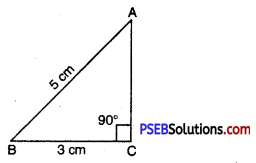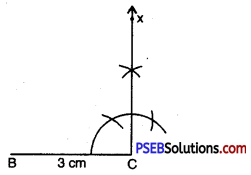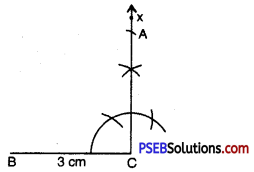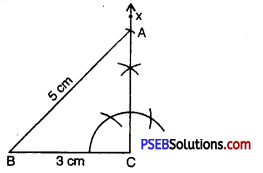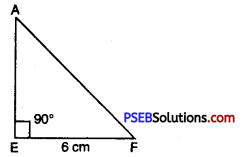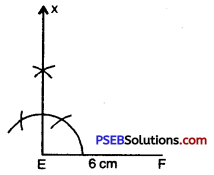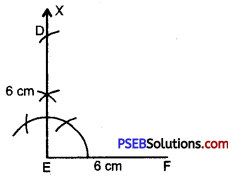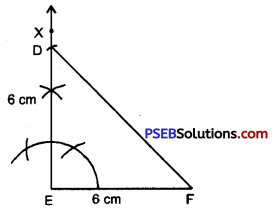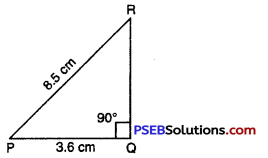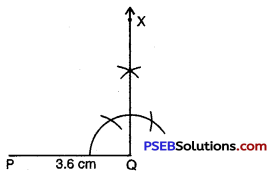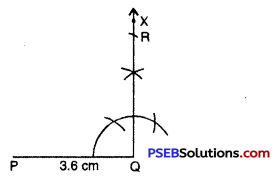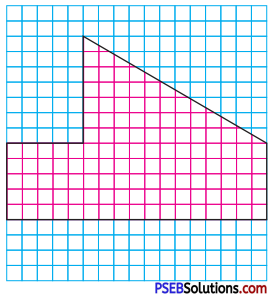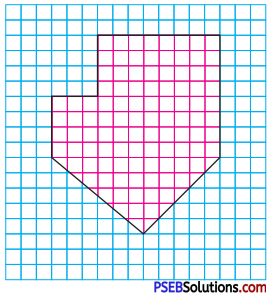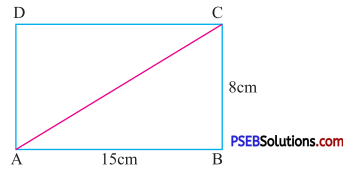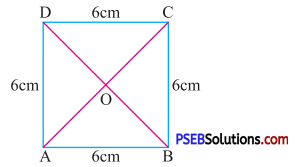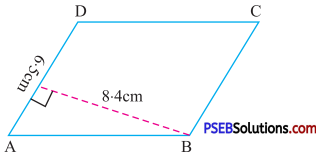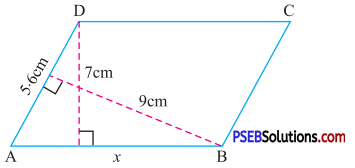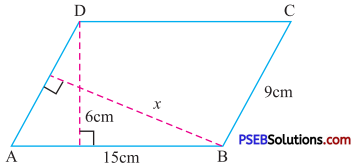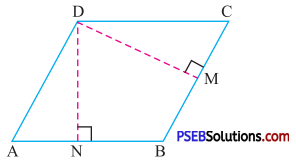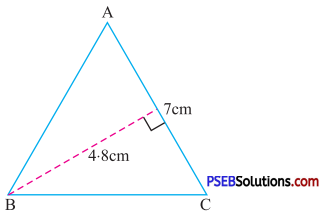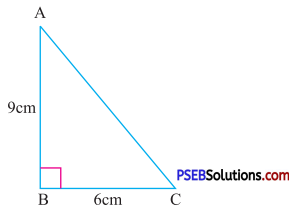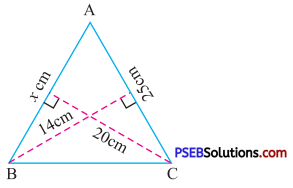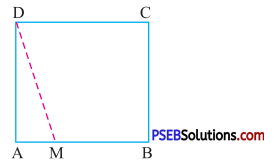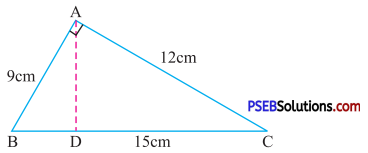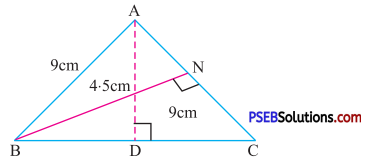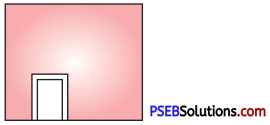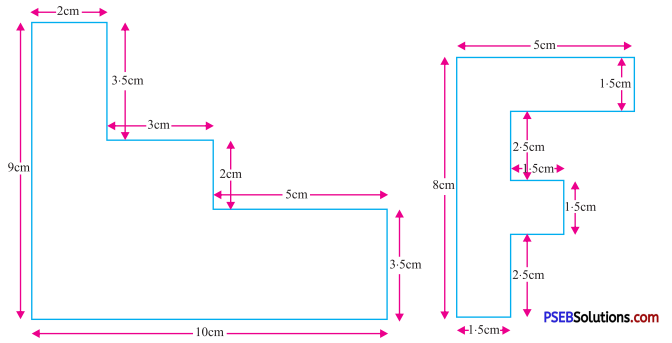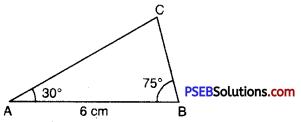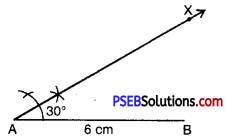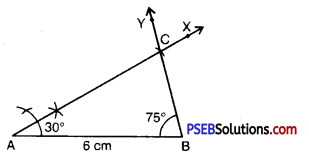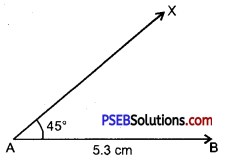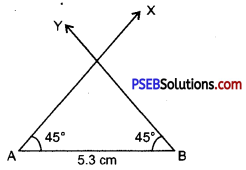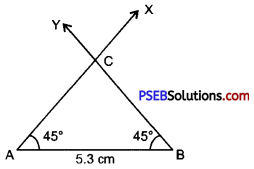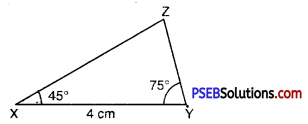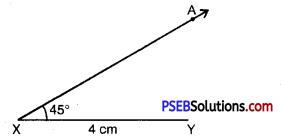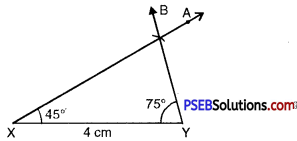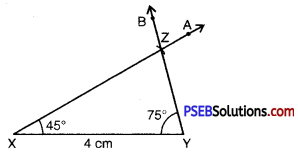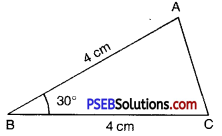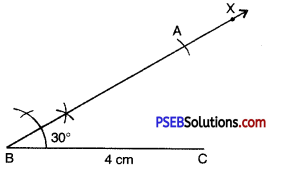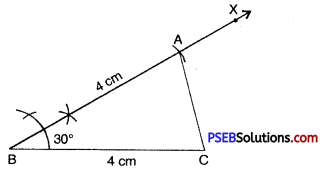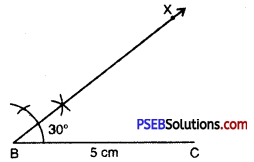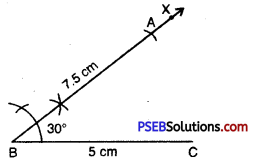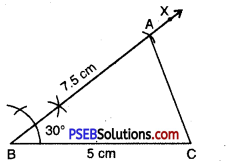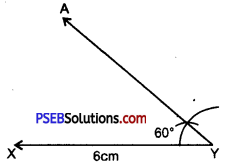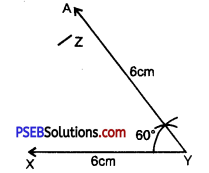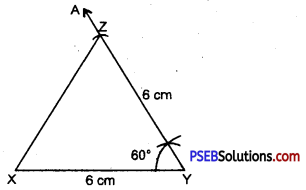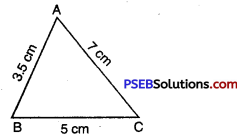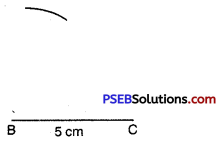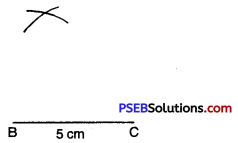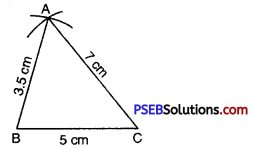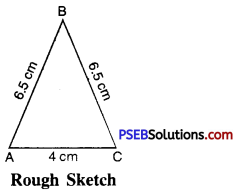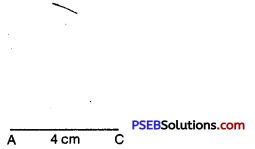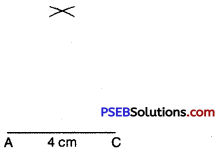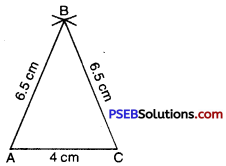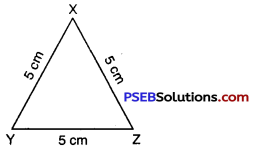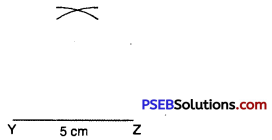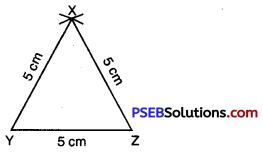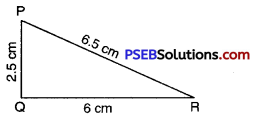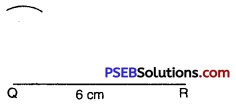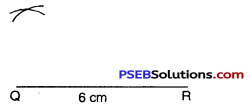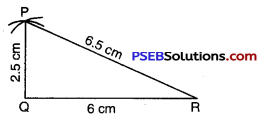Punjab State Board PSEB 7th Class Maths Book Solutions Chapter 4 Simple Equations Ex 4.3 Textbook Exercise Questions and Answers.
PSEB Solutions for Class 7 Maths Chapter 4 Simple Equations Ex 4.3
1. Solve each of the following equation.
Question (i).
6x + 10 = – 2
Answer:
Given equation is 6x + 10 = – 2
Transposing + 10 from L.H.S to R.H.S
we get
6x = -2 – 10
or 6x = -12
Dividing both sides by 6, we get
\(\frac{6 x}{6}=\frac{-12}{6}\)
or x = – 2, which is the required solution.
To check Put x = – 2 in the LHS of the equation 6x + 10 = – 2
L.H.S. = 6x + 10
= 6 × -2 + 10
= -12 + 10
= – 2 = R.H.S.
∴ L.H.S. = R.H.S.
Question (ii).
2y – 3 = 2
Answer:
Given equation is 2y – 3 = 2
Transposing – 3 from L.H.S. to R.H.S,
we get
2y = 2 + 3
or 2y = 5
Dividing both sides by 2, we get:
\(\frac{2 y}{2}=\frac{5}{2}\)
or y = \(\frac {5}{2}\), which is the required solution
To check. Put y = \(\frac {5}{2}\) in the L.H.S of the equation 2y – 3 = 2
L.H.S = 2y – 3 = 2 × \(\frac {5}{2}\) – 3
= 5 – 3 = 2 = R.H.S.
∴ L.H.S. = R.H.S.
Question (iii).
\(\frac{a}{5}\) + 3 = 2
Answer:
Given equation is \(\frac{a}{5}\) + 3 = 2
Transposing + 3 from L.H.S to R.H.S., we get
\(\frac{a}{5}\) = 2 – 3
or \(\frac{a}{5}\) = -1
Multiplying both sides, by 5, we get
5 × \(\frac{a}{5}\) = 5 × – 1
or a = – 5, which is the required solution.
To Check: Put a = – 5 in the L.H.S of the equation
\(\frac{a}{5}\) + 3 = 2,
L.H.S. = \(\frac{a}{5}\) + 3
= \(\frac {-5}{5}\) + 3
= – 1 + 3
= 2 = R.H.S.
∴ L.H.S. = R.H.S.

Question (iv).
\(\frac{3 x}{2}=\frac{2}{3}\)
Answer:
Given equation is \(\frac{3 x}{2}=\frac{2}{3}\)
Multiplying both sides by 2, we get
2 × \(\frac{3 x}{2}\) = 2 × \(\frac {2}{3}\)
or 3x = \(\frac {4}{3}\)
Dividing both sides by 3 we get
\(\frac{3 x}{3}=\frac{4}{3} \times \frac{1}{3}\)
or x = \(\frac {4}{9}\), which is the required solution.
To Check. Put x = \(\frac {4}{9}\) in the L.H.S. of equation \(\frac{3 x}{2}=\frac{2}{3}\)
L.H.S. = \(\frac{3 x}{2}=\frac{3}{2} \times \frac{4}{9}\) = \(\frac {2}{3}\) = R.H.S.
∴L.H.S. = R.H.S.
Question (v).
\(\frac {5}{2}\)x = -5
Answer:
Given equation is \(\frac {5}{2}\) x = – 5
Multiplying both sides by 2, we get
2 × \(\frac {5}{2}\) x = 2 × – 5
or 5x = – 10
Dividing both sides by 5, we get
\(\frac{5 x}{5}=\frac{-10}{5}\)
or x = – 2, which is the required solution.
To Check. Put x = – 2 in L.H.S. of the equation \(\frac {5}{2}\)x = – 5
L.H.S. = \(\frac {5}{2}\)x = \(\frac {5}{2}\) × -2
= – 5 = R.H.S.
∴ L.H.S. = R.H.S.
Question (vi).
2x + \(\frac {5}{2}\) = \(\frac {37}{2}\)
Answer:
Given equation is 2x + \(\frac {5}{2}\) = \(\frac {37}{2}\)
Subtract \(\frac {5}{2}\) from both sides, we get
2x + \(\frac {5}{2}\) – \(\frac {5}{2}\)
= \(\frac {37}{2}\) – \(\frac {5}{2}\)
or 2x = \(\frac{37-5}{2}\)
or 2x = \(\frac {32}{2}\)
or 2x = 16
Dividing both sides by 2, we get
\(\frac{2 x}{2}=\frac{16}{2}\)
or x = 8, which is the required solution.
To Check. Put x = 8 in the L.H.S. of the equation 2x + \(\frac {5}{2}\) = \(\frac {37}{2}\)
L.H.S. = 2x + \(\frac {5}{2}\)
= 2 × 8 + \(\frac {5}{2}\)
= 16 + \(\frac {5}{2}\)
= \(\frac{32+5}{2}\)
= \(\frac {37}{2}\) = R.H.S.
∴ L.H.S. = R.H.S.

2. Solve the following equation
Question (i).
5 (x + 1) = 25
Answer:
Given equation is 5 (x + 1) = 25
Dividing both sides by 5 we get
\(\frac{5(x+1)}{5}=\frac{25}{5}\)
or x + 1 = 5
Transposing 1 from L.H.S. to R.H.S. we get
x = 5 – 1
or x = 4, which is the required solution.
To Check. Put x = 4 in the L.H.S. of the equation 5 (x + 1) = 25
L.H.S. = 5 (x + 1)
= 5 (4 + 1)
= 5 (5)
= 25 = R.H.S.
∴ L.H.S. = R.H.S.
Question (ii).
2 (3x – 1) = 10
Answer:
Given equation is 2 (3x – 1) = 10
Dividing both sides by 2, we get
\(\frac{2(3 x-1)}{2}=\frac{10}{2}\)
or 3x – 1 = 5
Transposing – 1 from L.H.S. to R.H.S we get
3x = 5 + 1
3x = 6
Dividing both sides by 3, we get \(\frac{3 x}{3}=\frac{6}{3}\)
or x = 2, which is the required solution.
To Check. Put x = 2, in the L.H.S. of the equation 2 (3x – 1) = 10
L.H.S. = 2 (3x – 1) = 10
L.H.S = 2 (3x – 1) = 2 (3 × 2 – 1)
= 2 (6 – 1)
= 2 × 5
= 10 = R.H.S.
∴L.H.S. = R.H.S.
Question (iii).
4 (2 – x) = 8
Answer:
Given equation is 4 (2 – x) = 8
Dividing both sides by 4, we get
\(\frac{4(2-x)}{4}=\frac{8}{4}\)
or 2 – x= 2
Transposing 2 from L.H.S. to R.H.S. we get
-x = 2 – 2
or – x = 0
Multiplying both sides by – 1, we get
-x × – 1 = x – 1
or x = 0, which is the required solution.
To Check. Put x = 0 in the L.H.S. of the equation 4 (2 – x) = 8
L.H.S. = 4 (2 – x) = 4 (2 – 0)
= 4 × 2
= 8 = R.H.S.
∴ L.H.S. = R.H.S.

Question (iv).
– 4 (2 + x) = 8.
Answer:
Given equation is – 4 (2 + x) = 8
Dividing both sides by – 4, we get
\(\frac{-4(2+x)}{-4}=\frac{8}{-4}\)
Transposing 2 from L.H.S. to R.H.S. we get :
x = – 2 – 2
or x = – 4, which is the required solution
To Check. Put x = – 4 in the L.H.S. of equation – 4 (2 + x) = 8
L.H.S. = – 4 (2 + x) = – 4 [2 + (- 4)]
= – 4 (2 – 4)
= – 4 (- 2)
= 8 = R.H.S.
∴ L.H.S. = R.H.S.
3. Solve the following equations :
Question (i).
4 = 5 (x – 2)
Answer:
Given equation is 4 = 5 (x – 2)
or 4 = 5x – 10
Transposing 5x to L.H.S. and 4 to R.H.S.,
we get
– 5x = – 4 – 10
or – 5x = – 14
Dividing both sides by – 5, we get
\(\frac{-5 x}{-5}=\frac{-14}{-5}\)
or, x = \(\frac {14}{5}\), which is the required solution.
To Check. Put x = \(\frac {14}{5}\) in the R.H.S. of the equation 4 = 5 (x – 2)
R.H.S. = 5 (x – 2) = 5\(\left(\frac{14}{5}-2\right)\)
= 5\(\left(\frac{14-10}{5}\right)\)
= 5 \(\left(\frac{4}{5}\right)\)
= 4 = L.H.S.
∴ L.H.S. = R.H.S.
Question (ii).
– 4 = 5 (x – 2)
Answer:
Given equation is – 4 = 5 (x – 2)
or – 4 = 5x – 10
Transposing -4 to R.H.S and 5x to L.H.S
we get
-5x = 4 – 10 or -5x = -6
Dividing both sides by – 5 we get
\(\frac{-5 x}{-5}=\frac{-6}{-5}\)
or x = \(\frac {6}{5}\), which is the required solution.
To Check. Put x = \(\frac {6}{5}\) in the R.H.S. of the equation – 4 = 5 (x – 2)
L.H.S. = 5 (x – 2)
= 5\(\left(\frac{6}{5}-2\right)\)
= 5\(\left(\frac{6-10}{5}\right)\)
= 5\(\left(\frac{-4}{5}\right)\)
= -4 = L.H.S.
L.H.S. = R.H.S.
Question (iii).
4 + 5 (p – 1) = 34
Answer:
Given equation is 4 + 5(p – 1) = 34
Transposing 4 to R.H.S. we get
5(p – 1) = 34 – 4
5(p – 1) = 30
Dividing both sides, by 5, we get
\(\frac{5(p-1)}{5}=\frac{30}{5}\)
p – 1=6
Transposing -1 to R.H.S. we get
p = 6 + 1
p = 7 which is the required solution.
To Check : Put p = 7 in L.H.S. of the equation 4 + 5 (p – 1) = 34
L.H.S. = 4 + 5 (p – 1)
= 4 + 5 (7 – 1)
= 4 + 5 (6)
= 4 + 30
= 34 = R.H.S.
∴ L.H.S. = R.H.S.

Question (iv).
6y – 1 = 2y + 1.
Answer:
Given equation is 6y – 1 = 2y + 1
Transposing – 1 to R.H.S. and 2y to L.H.S,
we get
6y – 2y = 1 + 1
or 4y = 2 or y = \(\frac {2}{4}\)
or y = \(\frac {1}{2}\), which is the required solution.
To Check Put y = \(\frac {1}{2}\) in both L.H.S. and R.H.S. of the equation
6y – 1 = 2y + 1
L.H.S. = 6y – 1 = 6 × \(\frac {1}{2}\) – 1 = 3 – 1 = 2
R.H.S. = 2y + 1 = 2 × \(\frac {1}{2}\) + 1 = 1 + 1 = 2.
∴ L.H.S. = R.H.S.
4.
Question (i).
Construct 3 equations starting with x = 2
Answer:
First Equation.
(i) Start with x = 2
Multiplying both sides by 10
10x = 20
Adding 2 to both sides
10x + 2 = 20 + 2
or 10x + 2 = 22
This has resulted in an equation.
Second Equation. Start with x = 2
Divide both sides by 5
∴ \(\frac{x}{5}=\frac{2}{5}\)
This has resulted in an equation.
Third Equation. Start with x = 2
Multiply both sides by 5, we get
5x = 5 × 2
or 5x = 10
Subtracting 3 from both sides, we get
5x – 4 = 10 – 3
or 5x – 3 = 7
This has resulted in an equation.
Question (ii).
Construct 3 equation starting with x = – 2
Answer:
First Equation. Start with x = – 2
Multiplying both sides with 3, we get
3x = – 6
This has resulted in an equation
Second Equation. Start with x = – 2
Multiplying both sides with 3, we get 3x = -6
Adding 7 to both sides, we get 3x + 7
= -6 + 7 or 3x + 7 = 1
This has resulted in an equation.
Third Equation. Start with x = – 2
Multiplying both side with 2 we get 3x = – 6
Adding 10 to both sides we get
3x+ 10 = -6 + 10
or 3x + 10 = 4
This has resulted in an equation.

Multiple Choice Questions :
5. If 7x + 4 = 39, then x is equal to :
(a) 6
(b) -4
(c) 5
(d) 8
Answer:
(c) 5
6. If 8m – 8 = 56 then m is equal to :
(a) -4
(b) -2
(c) -14
(d) 8
Answer:
(d) 8
7. Which of the following number satisfies the equation – 6 + x = -18 ?
(a) 10
(b) – 13
(c) – 12
(d) – 16.
Answer:
(a) 10
8. If \(\frac{x}{2}\) = 14, then the value of 2x + 6 is equal to :
(a) 62
(b) -64
(c) 16
(d) -62.
Answer:
(a) 62

9. If 3 subtracted from twice a number is 5, then the number is :
(a) -4
(b) -2
(c) 2
(d) 4
Answer:
(d) 4
10. If 5 added to thrice an integer is – 7, then the integer is :
(a) – 6
(b) – 5
(c) -4
(d) 4
Answer:
(c) -4
![]()
![]()
